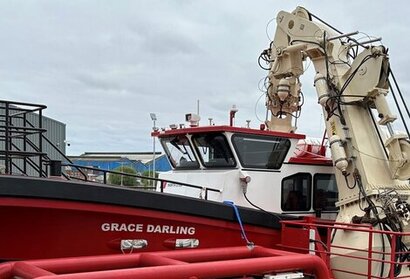
As the offshore wind industry scales to meet ambitious capacity targets, there is a growing demand for vessels that can operate effectively in challenging environments far from shore.
Crew Transfer Vessels (CTVs) and Service Operation Vessels (SOVs) currently form the backbone of offshore wind support vessel fleets. SOVs act as floating hubs for logistics and accommodation, while CTVs complement them by providing crews fast transit to and from port and around offshore wind farms.
However, the race to scale turbine technology and wind farm size has led to a ‘bigger is better’ approach to vessel procurement – particularly for CTVs. This situation has put significant pressure on an already stretched global shipping industry to build larger, more complex vessels – leading to a growing backlog of orders that is holding back the global expansion of offshore wind.
ORE Catapult predicts that more than 2,325 CTVs and 423 SOVs will be needed by 2050 to meet global offshore wind vessel demand for operations and maintenance (O&M) alone. Due to their enhanced operational capabilities, and the fact that they can be built by any shipyard using off-the-shelf-components, Daughter Craft could play a critical role in helping to meet future global vessel demand, alongside their CTV cousin.
With each new build SOV potentially able to accommodate two Daughter Craft, the market could – theoretically - see 846 of these ‘compact CTVs’ deployed by 2050, helping to meet up to a quarter of the total forecast CTV demand.
“To complement CTVs and SOVs and help meet growing vessel demand, the offshore wind industry urgently needs an innovative solution” said Andy Page, Founder and Managing Director of Chartwell Marine. “For too long, we’ve taken a ‘bigger-is-better’ approach to vessel procurement, but it’s time for us to ‘scale down to scale up’. Daughter Craft – a vessel class that has largely been overlooked to date – are perfectly placed to help address the current vessel shortage. With their unique characteristics and enhanced capabilities, there is a massive opportunity for Daughter Craft to increase operational and supply chain efficiencies within the offshore wind industry.”
By integrating the core strengths of CTVs into a smaller, more adaptable vessel, Chartwell argues next-generation Daughter Craft will play the role of a ‘Swiss Army Knife’ – creating significant efficiencies for offshore wind vessel operations across the following areas:
Transporting crews quickly, comfortable and safely around offshore wind farms from SOV motherships anchored on site – eliminating the conventional 2-hour CTV roundtrip to and from shore.
Maximising the reach of an on-site SOV, by enabling technicians to simultaneously service multiple wind turbines, cutting overall deployment times substantially.
Providing a designated safe refuge or emergency rescue option in situations where the SOV is required to operate beyond a 2-hour safe recovery range.
Acting as a temporary nearshore CTV – taking on less demanding logistical charters for wind farms located closer to shore.
Chartwell Marine’s Grace Darling - the first of its kind – was launched for SOV operator North Star in 2022. Since then, 10 Chartwell-designed Daughter Craft have entered operation, 6 are currently in build and more vessels are being commissioned across Europe, APAC and the USA. Purus became the latest SOV operator to launch a next-generation Daughter Craft in February 2025.
“Working with Chartwell Marine to create the ultimate offshore wind daughter craft has been an absolute pleasure” added Andrew Duncan, Renewables & Innovations Director at North Star. “We share common goals to innovate and push the boundaries of what could and should be achieved with this class of vessel. By improving on the previously accepted norm, and the operational limits by more than 50 percent, we have been able to increase ‘time on turbine’ and create significant operational and cost efficiencies for our clients. The fact that the vessel is more comfortable and efficient, and has enabled a local shipyard to return to building vessels in the UK, is a wonderful bonus.”
Beyond operational benefits, Daughter Craft offer major supply chain advantages. They are cheaper and quicker to build than traditional SOVs and CTVs. On average, Daughter Craft can be built for around 25 percent of the cost of a typical CTV and take 6-8 months to build – half the time of a traditional CTV.
Furthermore, they can be built efficiently by local boatyards using standardised construction kits and off-the-shelf components – helping to satisfy local content requirements in APAC and other markets.
For additional information:
“Daughter Craft: An integral addition to the offshore wind vessel family”

